"I have used these articles and information as my cheat sheet when diagnosing garden issue. The information is primarily from http://www.gardensalive.com I found this site helpful in my growing woes plus they carry a lot of organic grower items. I use them as a tool but their prices are a bit high. Judge for yourself some times you get what you pay for. " Bruno Suraci
Garden Pest
Beetles
Bean Leaf Beetle
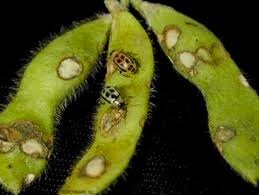
Description: Orange red or green with black head and black spots. Adult beetles lay eggs in soil at the base of seedlings. Larvae feed underground on roots and stems, making stems weak and susceptible to breaking. Adults riddle leaves, especially on early maturing bean plants. Solutions: Super-Light Insect Barriers are very effective. Grub-Away® Nematodes, applied at or shortly after planting time, control larvae. Spray kaolin clay as soon as you notice the beetles. Repeat every 7-14 days. We recommend Surround At Home Crop Protectant.
Blister Beetles
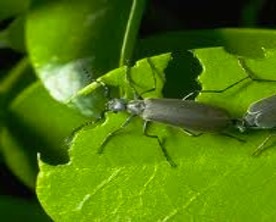
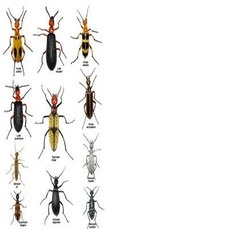
Description: Yellow or gray with black stripes. The 1/2" long beetle can cause blisters on the skin if crushed by hand. Blister beetles feed in swarms, eating foliage and blossoms of almost any vegetable. Solutions: Gardening aids such as Floating Row Covers or Super-Light Insect Barriers are excellent deterrents to crop damage caused by pests.
Colorado Potato Beetle
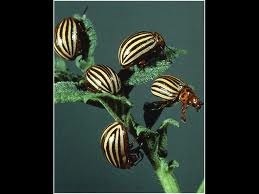
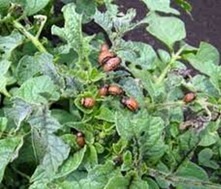
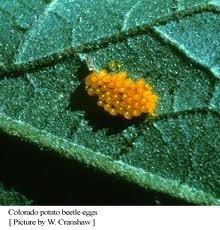
Description: Adult beetle has a yellow body with black stripes running downward. Red larva grows to 3/5" long with rows of black spots along its sides. Favorite foods are potato, eggplant, pepper and tomato. Adults and larvae feed on leaves and stems, often stripping entire plants. Small garden plantings seem to be particularly vulnerable to damage. Solutions: Sta-Home™ Lady Beetles eat the beetle eggs and Grub-Away Nematodes kill the larvae when they move to the ground. Products containing spinosad, derived from the fermentation juices of a soil bacterium, are effective in controlling both larvae and adults. We recommend Bull’s-Eye™ Bioinsecticide.
Spotted Cucumber Beetle
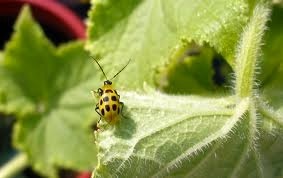
Description: The spotted cucumber beetle is notorious for spreading cucumber bacterial wilt. Body is 1/4" long, yellowish green with 12 distinct black spots on its wings. Larvae grow to 1/2" long. The striped cucumber beetle is 1/5" long with yellow-and-blackstriped wings. Their preferred foods: cucumbers, beans, melons, squash, pumpkins, corn and eggplant. Beetles lay their eggs in the ground near the base of the plant on which they feed. The larvae, also called corn rootworms, tunnel through vegetable roots, feeding for 2-4 weeks. Injured plants turn yellow and break off. Adult beetles end hibernation in the spring and suddenly appear in large numbers on vine and bean crops. Leaves are riddled and turn yellow. Solutions: Apply kaolin clay in early summer prior to beetle infestation. Continue application every 7-14 days until harvest. Reapply after heavy rains. For adult beetles, use pyrethrins and rotenone. Kaolin clay can be tank-mixed with pyrethrins and rotenone, if cucumber beetle pressure is heavy. We recommend Surround At Home Crop Protectant and Liquid Rotenone/Pyrethrins Spray. For larvae, apply Grub-Away Nematodes. Super-Light Insect Barriers shield plants up to blossom time, when the covers must be removed for pollination.
Flea Beetles
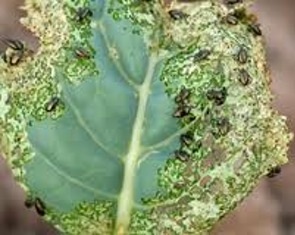
Description: Black, often with a curved yellow or white stripe on either side of its back. Flea beetles are seldom actually seen; they hop away before you get close enough to see them. They eat nearly all garden crops. The adults are very troublesome when seedlings are set out. Leaves become riddled with little holes, chewed through from the underside of the leaf. Larvae chew on roots of most vegetables, weakening the plant. Solutions: We have obtained excellent results using Super-Light Insect Barriers on crops where pollination is not required. Apply kaolin clay products on young plants and continue coverage every 7-14 days until harvest. Otherwise, use pyrethrins and rotenone on adults beetles and Grub-Away Nematodes on larvae. We recommend Surround® At Home® Crop Protectant, Pyola® Insect Spray and Liquid Rotenone/Pyrethrins Spray.
Japanese Beetle
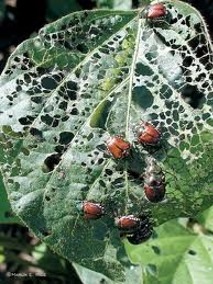
Description: Metallic green-copper adult grows to 1/2" long. Larvae or grubs are grayish white with brown head; fat body is 3/4" long. Adults especially like beans and corn but will eat almost any plant, often skeletonizing the leaves. Larvae chew on roots of lawn grass, bean, beet, sweet corn, onion and tomato plants; their root pruning severely reduces crop yields and can kill grass. Growth of grubs and root damage is mostly in June. Adults cause damage from late June to early September. Solutions: To protect lawn grass roots from chewing damage by grubs, apply Grub-Away® Nematodes at the rate of 10 million per 600 sq. ft. of lawn. Lawn- Gard™ Bioinsecticide kills grubs and other lawn insects; won’t wash out with repeated rainfall. For adult beetles, use kaolin clay as soon as adult beetles are noticed. Continue spraying every 7-14 days during the growing season; increase interval to 14-21 days as plant growth slows. Reapply after heavy rains. Otherwise, apply pyrethrins to kill them (note: you can mix kaolin clay with pyrethrins if pest pressure is heavy); or use Japanese Beetle Trap with pheromone lures to mass trap them. Set out traps in mid June, before beetles emerge, preferably in sunny locations. We recommend Surround® At Home® Crop Protectant and Pyola® Insect Spray.
Mexican Bean Beetle
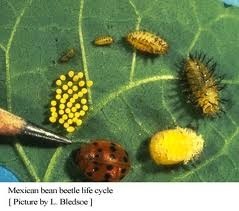
Description: Bean beetle adults are yellow brown, 1/4" long, with 16 black spots; they are frequently mistaken for lady beetles but lady beetles have a varying number of spots. The larvae are yellow orange, spined, 1/3" long. Both adults and larvae prefer beans. They skeletonize leaves and can strip a plant to its stems quickly. Solutions: Kaolin clay, which forms a barrier film when sprayed on fruits and vegetables, can be used to deter insect damage. We recommend Surround At Home Crop Protectant.
Plum Curculio
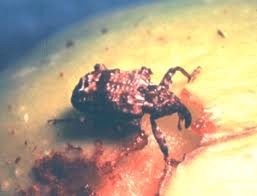
Description: Adult beetle, black or brownish black, is about 1/4" long, very hard, and has a beak 1/4 as long as its body. It prefers apples and stone fruits (peach, plum, etc.). Adults overwinter in the trash beneath trees, in fence rows, or in wooded areas. In spring they begin appearing at late bloom. Larvae bore to the center of the fruit immediately after emerging from the egg and feed near the core. After completing growth, the larvae bore to the outside and drop to the ground. Through most of the season, eggs are laid under the skin of fruits. Larval injury is extensive and usually causes fruit to fall before larva completes growth. Solutions: Use kaolin clay products early in spring (green bud stage). Continue spraying every 7-14 days during the growing season; keep young fruit coated; increase interval to 14-21 days as plant growth slows. Reapply after heavy rains. We recommend Surround At Home Crop Protectant. Clean up damaged fruit to prevent larvae from getting into soil. Spray Grub-Away® Nematodes wherever apples drop to reduce next year’s curculio population.
Small Insects
Aphids
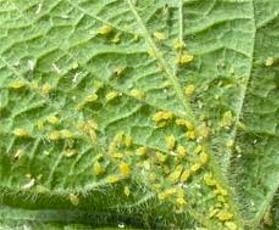
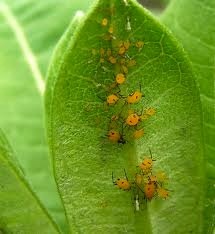
Description: Tiny bugs that may be green, yellow, orange or black, as well as other colors; with or without wings. The largest is 1/6" long; the smallest is barely visible. They cluster on stems and under leaves. Aphids may cause more crop damage than any other insect, and there are few plants they don’t like. Infested leaves curl and turn yellow; plant is weakened in general. Greatest damage occurs after a cold spring; aphids increase faster than their natural enemies during a chilly season. Solutions: Aphids are among the pests most easily controlled by biological methods;
Green Lacewings are excellent predators, and Sta-Home™ Lady Beetles help reduce heavy populations.
Pot Stickers help control the small number of flying aphids that may appear indoors or on individual plants outdoors. Horticultural oils, insecticidal soaps and pyrethrins also can be utilized. We recommend
Oil-Away™ Supreme Insecticidal Oil, Plant Guardian™ Houseplant Insecticidal Soap and Pyola® Insect Spray.